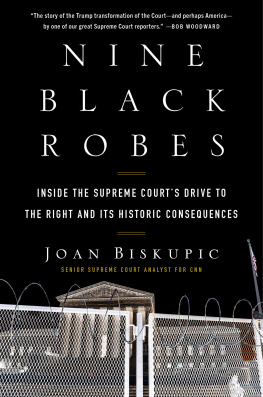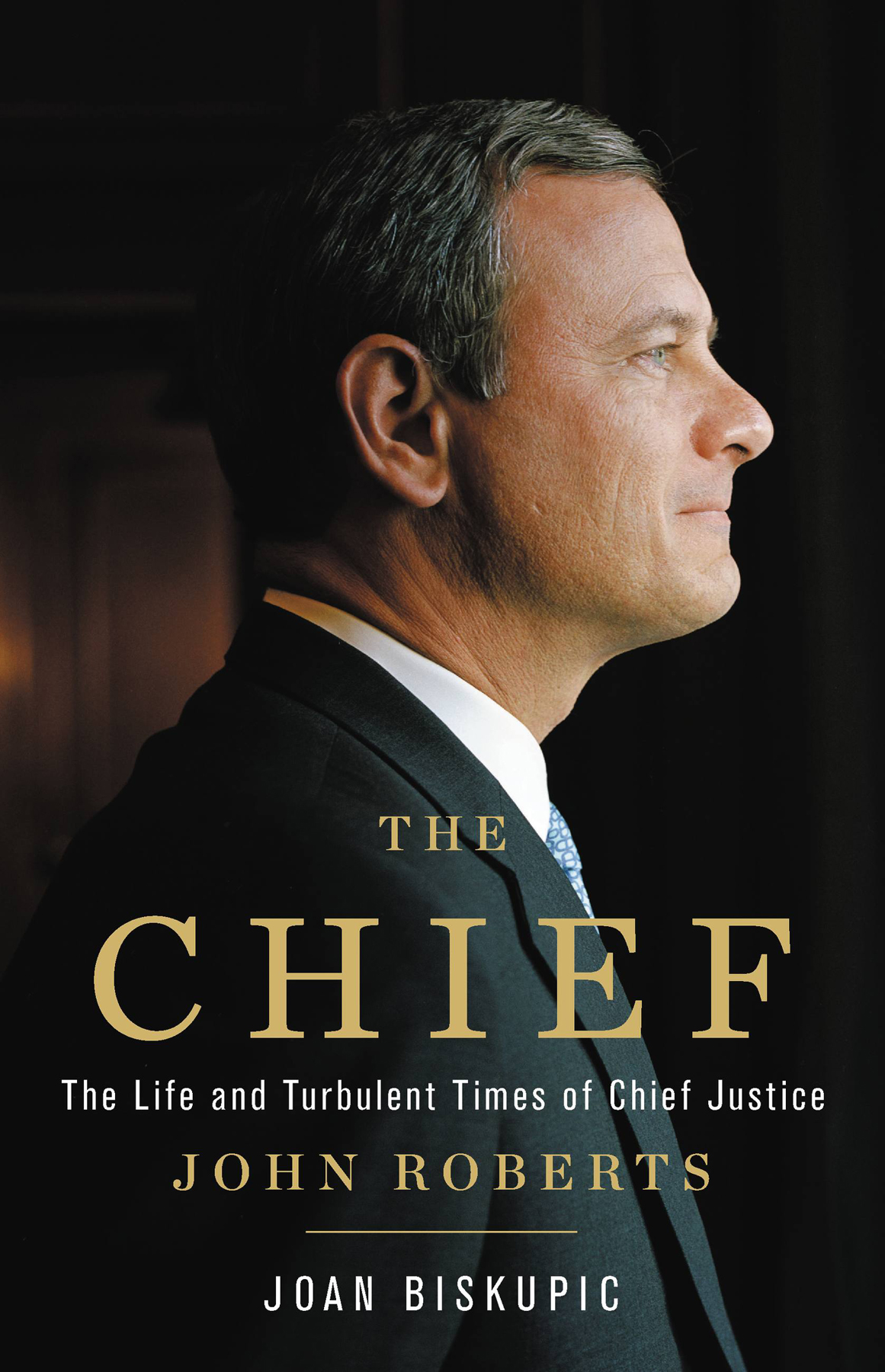Copyright 2019 by Joan Biskupic
Cover design by Chin-Yee Lai
Cover image Steve Pyke/Contour by Getty Images/courtesy of the New Yorker
Cover 2019 Hachette Book Group, Inc.
Hachette Book Group supports the right to free expression and the value of copyright. The purpose of copyright is to encourage writers and artists to produce the creative works that enrich our culture.
The scanning, uploading, and distribution of this book without permission is a theft of the authors intellectual property. If you would like permission to use material from the book (other than for review purposes), please contact permissions@hbgusa.com. Thank you for your support of the authors rights.
Basic Books
Hachette Book Group
1290 Avenue of the Americas, New York, NY 10104
www.basicbooks.com
First Edition: March 2019
Published by Basic Books, an imprint of Perseus Books, LLC, a subsidiary of Hachette Book Group, Inc. The Basic Books name and logo is a trademark of the Hachette Book Group.
The Hachette Speakers Bureau provides a wide range of authors for speaking events. To find out more, go to www.hachettespeakersbureau.com or call (866) 376-6591.
The publisher is not responsible for websites (or their content) that are not owned by the publisher.
Library of Congress Cataloging-in-Publication Data
Names: Roberts, John G., 1955author. | Biskupic, Joan, author.
Title: The Chief : the life and turbulent times of Chief Justice John Roberts / John Roberts, Joan Biskupic.
Description: New York : Basic Books, [2019] | Includes bibliographical references and index.
Identifiers: LCCN 2018039502 (print) | LCCN 2018039671 (ebook) | ISBN 9780465093281 (ebook) | ISBN 9780465093274 (hardcover : alk. paper)
Subjects: LCSH: Roberts, John G., 1955 | JudgesUnited StatesBiography. | United States. Supreme CourtOfficials and employeesBiography. | United States. Supreme CourtHistory.
Classification: LCC KF8745.R6 (ebook) | LCC KF8745.R6 A3 2019 (print) | DDC 347.73/2634 [B]dc23
LC record available at https://lccn.loc.gov/2018039502
E3-20190304-JV-NF-ORI
Joan Biskupic has written the definitive account of the consummate lawyer and deft politician at the helm of our nations judiciary. Avoiding legal jargon while steering clear of slogans and stereotypes, Biskupic paints a highly readable and deeply informative three-dimensional portrait of the man whom fate has placed front and center in an unfolding drama bound to shape American life for decades to come.
L AURENCE T RIBE , professor of Constitutional Law, Harvard University
Joan Biskupic draws on meticulous reporting and deep knowledge of the Supreme Court to bring us a fascinating real-time portrait of Chief Justice John Roberts, one of the countrys most powerful but least known individuals, a man now in a unique position to shape the law in the age of Trump.
L INDA G REENHOUSE , lecturer at Yale Law School and former New York Times Supreme Court correspondent
Breaking In: The Rise of Sonia Sotomayor and the Politics of Justice
American Original: The Life and Constitution of Supreme Court Justice Antonin Scalia
Sandra Day OConnor: How the First Woman on the Supreme Court Became Its Most Influential Justice
F OR C LAY AND E LIZABETH
O N A STICKY EIGHTY-DEGREE J UNE MORNING, THE US S UPREME Court ascended the bench at 10:00 for the last sitting of the 20172018 session. Chief Justice John Roberts knew what would happen later that morning. Most of the other justices did not. For the second time in two years, a dramatic change among the nine would test the man who was presiding over Americas highest court.
At sixty-three, Roberts still had a fit, compact physique that recalled his days as a high school wrestler. His neatly trimmed brown hair was graying. He exuded a pleasant, regular-guy earnestness, and he often referred to his Indiana childhood. Yet he was no average midwestern boy. Roberts appeared to have been hardwired from birth for success. The son of a steel company executive, he had attended an elite boarding school, earned a Harvard bachelors degree in three years, and then attended Harvard Law School. He had become a sterling oral advocate, arguing his first case before the Supreme Court at the age of thirty-four. By then he had spent several years clerking, serving in the Reagan administration, and working in a Washington, DC, law firm. He was known for his powers of persuasion and tireless preparation. He was also known for an austere law firm office notably lacking in photos and personal mementos.
By dint of drive and intellectand the political connections he had forgedRoberts had become chief justice of the United States in 2005. Then just fifty years old, he was the youngest new chief in more than two centuries. President George W. Bush had initially nominated him as an associate justice to replace Sandra Day OConnor after she announced that summer she intended to retire. But before Robertss Senate hearings could be held, Chief Justice William Rehnquist died. At the time, the Bush administration was besieged by criticism over its handling of the collapse of civil order in New Orleans during Hurricane Katrina, one of the countrys deadliest natural catastrophes. Within hours of Rehnquists death, Bush decided to elevate Roberts, brushing away advisers who suggested he choose an older, more experienced nominee.
When he appeared before the Senate Judiciary Committee, Roberts was composed, confident. Watching Roberts on television was like watching one of the radiantly wholesome heroes that Jimmy Stewart and Henry Fonda played, Janet Malcolm commented in The New Yorker. It was out of the question that such a man be denied a place on the Supreme Court.
O N J UNE 27, 2018, AS HE WAS FINISHING HIS THIRTEENTH YEAR AS chief justice, the first order of business was the announcement of decisions in the last cases from the session that had begun back in October. The term had been difficult, and the Court had delivered more fractious 54 rulings than usual. The ideological conflicts among them had spilled out with greater spite. The days most awaited dispute, concerning whether states could allow unions to collect fees from non-union members to support collective bargaining activities, reinforced that pattern. By another 54 vote, with conservatives prevailing over liberals, the justices ruled against Americas already struggling labor unions and declared the fees a violation of First Amendment free-speech rights. The decision overturned a 1977 ruling that had let states require fair share fees of non-members to finance unions efforts on behalf of employee pay and benefits but not political activities.
In the courtroom seats reserved for the justices guests were, as was customary on the last day of the term, spouses of the justices. Among them was Mary Kennedy, the wife of Justice Anthony Kennedy, the Courts pivotal central-conservative justice, who had steadied the Court for decades. He was about to turn eighty-two. He was weary and weathering several health problems. So was Mary, whom he had known since their childhood in Sacramento. Justice Kennedy had been less engaged at oral arguments over the past session. Even with hearing aids tucked behind his ears under his gray, thinning hair, he had trouble following some conversations. His six-foot-three frame hunched a bit more as he walked.
But most of his colleagues believed Kennedy was not ready to retire. His influence on the law in America could not be overstated. He had held the key vote in so many cases that the Roberts Court was sometimes known among lawyers and the news media as the Kennedy Court. Yet, unlike at the end of most annual sessions, Kennedys voice was not heard at all this day, either with one of the final big rulings or a retirement announcement from the bench. Justices Samuel Alito and Elena Kagan provided the rhetorical drama with their dueling opinions in the labor union case. Speaking on behalf of the conservative majority, Alito declared that unions had gotten an undeserved windfall for four decades. For the dissenting liberals, Kagan argued that the majority was weaponizing the First Amendment and throwing out a precedent not on principle but for the sole reason that the justices on the right did not like it. There was no denying the political overtones in a case involving labor. Big loss for the coffers of the Democrats! President Donald Trump responded immediately on Twitter.




